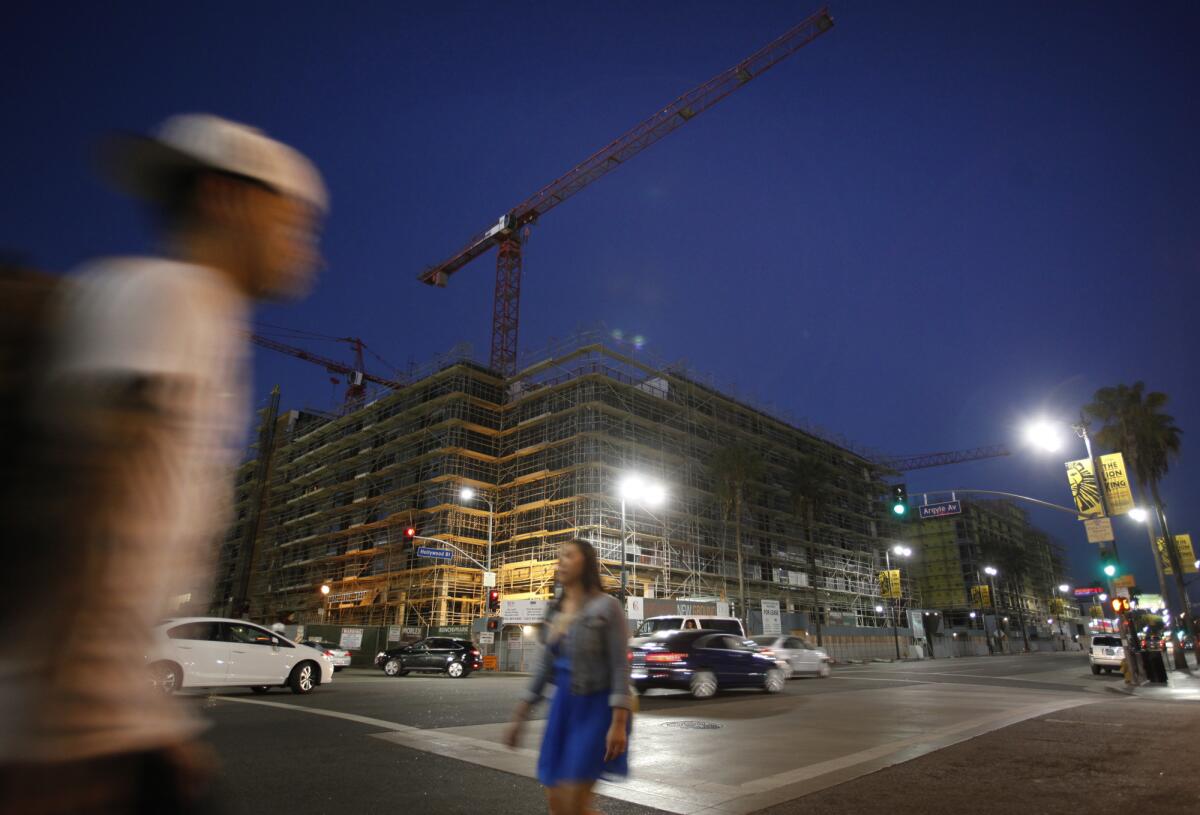Hollywood developer fights quake fault designation

An earthquake fault line should not be drawn underneath Blvd6200, one of Hollywood’s largest residential and commercial projects, a lawyer for the developer said Thursday.
The lawyer, John M. Bowman, told the state Mining and Geology Board that the fault line drawn by the California Geological Survey “is not clearly detectable … and therefore is not sufficiently well-defined to be included on the map.”
A geologist for the developer, Reinard Knur, said he wants to do more studies to support their request the state either delete that section of the fault or move it farther north on its new proposed zoning map. The developer performed some studies this week and plans to submit additional information. The state geologist is scheduled to publish a final draft of the Hollywood earthquake fault zone map this summer.
State geologist John Parrish said he welcomes any new data. But so far, he said, the developer’s geologist has not provided evidence that backs up an alternate location of the fault.
Parrish said there is plenty of evidence that the fault is underneath Blvd6200: uneven groundwater levels, underground fractured bedrock and the hillside.
He said they point to past earthquakes where one side of the fault rose past the other — creating a barrier between both sides of the fissure.
“You have to make all the evidence fit. And this is the best fit for all the evidence we have in hand at this point,” Parrish said.
In a letter to the board, the developer’s lawyer wrote that the state’s proposed fault line map is “based on evidence that is inaccurate or incomplete,” failing to consider other more likely explanations that aren’t caused by earthquakes.
The California Geological Survey in January released its draft map of the Hollywood fault, which put fault lines underneath three prominent development projects in Hollywood. In addition to Blvd6200, the map shows the fault crossing a proposed apartment complex on the southwest corner of Yucca Street and Argyle Avenue and the proposed Millennium Hollywood skyscraper towers.
The release of the map requires that anyone seeking to develop property in the earthquake fault zone conduct rigorous studies to confirm that the building would not be on top of an earthquake fault. Structures directly on top of faults can be destroyed during a major earthquake when one side of the building’s foundation moves past the other.
But the state’s new fault map would not halt Blvd6200’s construction, which was signed off by Los Angeles building officials and broke ground in 2012.
Knur, the geologist for the developer, told state geology board members Thursday that he planned to do more testing on the site.
Doing so could be difficult. The time to do the analysis to find a fault is before construction, when crews can dig trenches and prove whether a fault exists underneath the site, Parrish said. The developer did not complete a fault investigation before construction, and the building is nearly complete.
“You can argue, but you have to be persuasive with the evidence that’s there,” Parrish said. “If someone comes up with something that’s overriding all of that … we’d be glad to accept it.”
Parrish said that many previous studies done in the area — including published research in the 1990s and investigations done for the Metro subway — suggested that a fault investigation would’ve been a good idea.
“So a prudent developer … and maybe the planning department would have said, ‘It’s best to do a fault study here,’” Parrish said.
Careful study of a trench on a property is considered by seismic experts to be the best way to determine the path of a fault.
Across the street from Blvd6200, a fault study is underway at a proposed apartment complex at 6230 Yucca Street, where an enormous trench was dug in recent weeks.
Parrish, the state geologist, said the California Geological Survey has visited the Yucca Street trench once but has not been invited to return. He said it would be helpful to deepen, widen and extend the trench further south, into the Millennium Hollywood property, for a better look.
“When we visited, the trench was not deep enough and the entire bottom level was inaccessible due to safety reasons,” Parrish said.
David Jordon, the owner of the project, said there were no plans to extend the trench further and that he is putting together a report for city officials for review and approval.
Millennium officials last summer said they believe the fault does not cross the project site, but agreed to do further fault investigations, including a trench study.
Officials later said they were holding off on the trench until lawsuits opposing the project are resolved.
More to Read
Sign up for Essential California
The most important California stories and recommendations in your inbox every morning.
You may occasionally receive promotional content from the Los Angeles Times.












